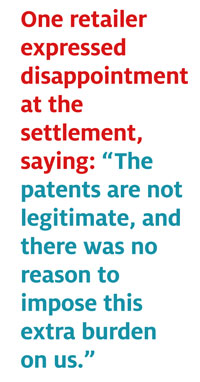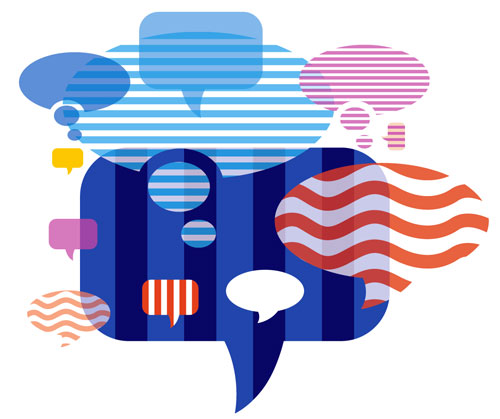About four years ago, retailers began switching their focus from using radio frequency identification to track pallets and cases in their supply chains to monitoring unique items in stores. This shift was driven, in part, by studies conducted by the RFID Research Center at the University of Arkansas that showed using passive ultrahigh-frequency RFID systems to take inventory of apparel in stores could increase inventory accuracy from roughly 65 percent to more than 95 percent. Subsequent trials found that improved in-store inventory accuracy often led to an increase in sales.
During the past few years, Bloomingdale’s, Macy’s, Lord & Taylor, Saks and other U.S. retailers announced they were using RFID in stores. This year, the pace of retailers worldwide adopting RFID technology to manage inventory has picked up (see “Retailers Already Sold on RFID”).
Now, some retailers are deploying innovative RFID solutions to capture customers’ attention and make a sale. Here’s a look at some of the new applications being rolled out by retailers.
Alex and Ani, a U.S. jewelry and apparel retailer, deployed Bluetooth Low Energy (BLE) beacons at all 40 of its branded stores in an effort to engage customers by sending data directly to their mobile phones while they shop. The beacons, which are essentially active RFID transponders, were supplied by in-store mobile marketing company Swirl Networks. If a shopper has a Swirl In-Store Explorer application running on his or her handset, that individual can receive product information on the phone, based on the in-store location of that beacon (and, thus, that customer). The retailer is also able to collect information regarding customer interest and traffic. Timberland and Kenneth Cole also have adopted the solution (see Alex and Ani Rolls Out Swirl’s Bluetooth Beacons at 40 Stores).
Several retailers are planning to deploy a similar system developed by U.K.-based startup Iconeme, which uses BLE technology to enable store mannequins to transmit data to customers. The VMBeacon solution consists of a beaconing device installed inside a mannequin that transmits a signal to the Bluetooth reader built into a consumer’s phone. In that way, individuals who pass in front of mannequins, either in a store or at a store window, can receive information about the garments that mannequin is wearing, including sizes, colors, prices and online buying options, as well as coupons (see Iconeme Launches Bluetooth Beacon Solution for Mannequins).
Tarrytown Pharmacy, in Austin, Texas, deployed a series of hybrid beacons—combining BLE and Near Field Communication technologies—to enable customers to access coupons and promotional information regarding products via a simple tap of their mobile phones. The solution, provided by startup Shelfbucks, consists of the beacons and a Shelfbucks application that consumers download to display product and promotional information. If, for example, a customer taps a Shelfbucks beacon located in the store’s cold and flu products section, he or she can receive information about facial tissues currently on sale (see Shelfbucks’ Bluetooth-NFC Beacons Bring Discounts to Tarrytown Pharmacy’s Shoppers).
Swiss online fashion company Heidi.com opened a brick-and-mortar store in Neuchâtel, Switzerland, where customers can purchase in-store merchandise and other products from the retailer’s website. To make this possible, the retailer is issuing NFC loyalty cards to customers and has installed NFC readers in two large digital touch-screen kiosks known as “totems,” which display a changing lineup of products. If a shopper sees something she wants, she can select the product and check its availability. If it is located in the store, she is directed to its location. If not, she can request that it be shipped to her home or delivered to the store for future pickup. In either case, she will receive a text message or e-mail containing a link to Heidi.com, where she can complete the transaction by approving a credit-card payment (see Heidi.com’s New Store Uses NFC RFID to Enable Omni-Channel Shopping).
Social-Media Shopping
A few years ago, there was a lot of buzz about applications that allowed a consumer to take a picture of herself in an outfit and e-mail the photo to friends or family members to get their input. Store fixtures incorporating the technology never caught on, but Ritani, a Seattle, Wash.-based jewelry company, has a new take on social-media shopping. The company recently launched a multistore pilot of an RFID solution that enables retailers selling Ritani jewelry to automatically display information about merchandise customers ask to see—and allow those shoppers to share the items’ images and descriptions with friends prior to or after making a purchase. Store management can collect data regarding sales-floor behavior, including items viewed, percentage purchased and employees’ sales rates (see Ritani Creates RFID Solution to Engage Shoppers, Increase Sales).

Enhancing Products
Designers that sell their own products online are using RFID to add pizzazz to individual items. Aki Choklat, a designer of shoes and accessories, for example, is selling a lady’s handbag that links a digital record about each unique handbag with the physical product, via an NFC tag positioned under the label and an application the buyer uses to access the data. In addition, a smartphone application developed for Aki Choklat allows the bag owner to create a travel diary (see Aki Choklat Brings Authentication and Personalization to Luxury Bags).
Four Levent, a Swedish men’s clothing startup, has begun marketing what it calls wearable technology, consisting of a shirt with an NFC tag embedded in each cuff. The tags are intended to transmit data—such as information about the shirt, or the wearer’s contact information, company URL or full business card—to an NFC-enabled mobile phone (see Swedish Men’s Shirts Provide Off-the-Cuff Info).
It isn’t clear yet which, if any, of these applications will catch on with consumers and become widely adopted by retailers. But it is clear that RFID is becoming a permanent store fixture.
Retailers Already Sold on RFID
The following companies are among those that announced this year they are using RFID in their operations.
Belt Liquors
The U.S. liquor retailer installed an RFID system that has eliminated the problem of tracking cases of product in its warehouse, which is adjacent to the store. Thanks to the solution, which the beverage company installed itself, managers now know what product is in the warehouse, and can conduct quick inventory checks at any given time to determine if that has changed (see Colorado Liquor Retailer Gets Quick Payback From Low-Cost RFID Solution).
Coccinelle
The Dutch retailer of children’s clothing is employing RFID to improve inventory accuracy at its distribution center and stores, to ensure goods ordered online are, in fact, available, enabling the retailer to avoid having to cancel those transactions. Since the system was deployed, online sales cancellations have dropped by 60 percent (see Coccinelle Finds RFID Virtually Eliminates Out-of-Stocks for Store and Online Sales).
Intersport Jan Bols
The athletic equipment and clothing store in Hoogeveen, the Netherlands, has boosted sales and decreased inventory-monitoring costs thanks to an RFID solution that tracks approximately 10,000 items storewide, from back room to point of sale. Intersport International, based in Switzerland, is now deploying the technology at 10 additional Intersport locations throughout the Netherlands (see Intersport Expects RFID to Boost Its Sales, Decrease Its Costs).
ISA Boutique
This China retailer installed an RFID system to track fine jewelry. In addition to reducing out-of-stocks, the solution monitors when a piece of jewelry is removed from a cabinet and returned—and how often, providing analytics regarding how well customers like each item. The retailer is now planning to install the technology at another store (see ISA Boutique Tracks Inventory, Shopper Behavior via RFID).
Kohl’s
The U.S. department store installed an RFID solution to track garments in select categories at its stores and distribution centers. Now, a large number of strategic apparel items, including footwear, denim and men’s basics (such as underwear and T-shirts) are being tagged at various points along the supply chain, and then counted during regular inventory cycle counts via handheld readers (see Kohl’s Rolls Out RFID for Select Product Categories at Its Stores).
Made.com
The designer-brand online furniture retailer is providing customers at its London showroom with tablets they can use to read NFC tags to learn about each product, while giving the retailer access to data about shopper behavior and preferences (see Online Furniture Retailer Adds RFID to Its Brick-and-Mortar Showroom).
Tara-Espen Dronsett, Follestad and Høyer
These three stores are among more than 40 fashion boutiques and small retailers throughout Norway that have begun using an RFID solution to reduce the amount of manual labor previously required to conduct inventory counts and ensure that goods are available when customers want them (see Small Stores in Norway See Payback From RFID).
Zara
The Spanish clothing retailer is using RFID in all its distribution centers and at more than 700 stores in 22 countries. Parent company Inditex revealed it expects to have the technology installed at nearly 2,000 Zara locations by 2016, with plans for a gradual rollout across the rest of its chains worldwide (see Inditex CEO Announces RFID Expansion Plans).


